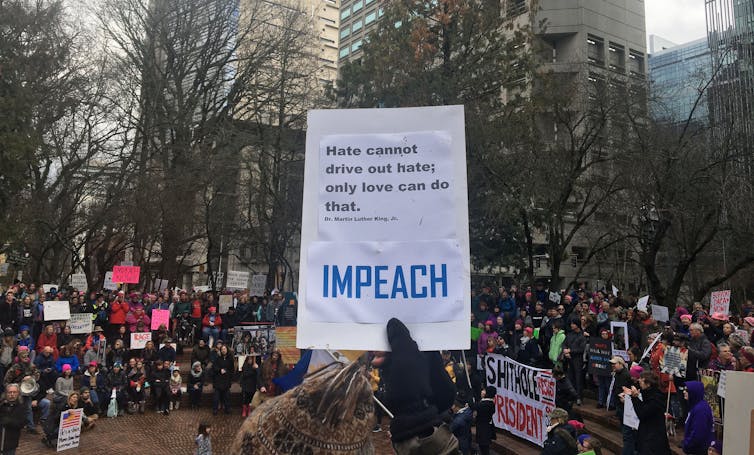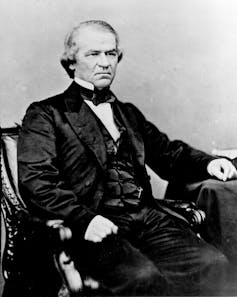Mark Meigs, Université Paris Diderot
On September 24, 2019, US Speaker of the House Nancy Pelosi announced that the House of Representatives had launched a formal impeachment inquiry against President Donald Trump.
While the announcement was a shock, it didn’t come out of thin air given that there has been impeachment talk since the day Trump unexpectedly won the 2016 election, a contest marred by interference from Russian hackers. The speculation ramped up with every twist and turn of investigation by special counsel Robert S. Mueller, during which 34 figures associated with Trump – including former campaign manager Paul Manafort, former national security advisor Michael Flynn and his personal lawyer Michael Cohen – were indicted, convicted or pleaded guilty. Mueller chose to not bring charges against the president himself, however, yet specifically did not exonerate him.
What pushed the House of Representatives to finally launch a formal investigation are allegations that Trump repeatedly urged Volodymyr Zelensky, the president of Ukraine, to find compromising information on the son of former US vice-president Joe Biden, one of the leading candidates for the 2020 presidential election. In a possible attempt to encourage Zelensky to cooperate, the Trump administration had frozen military aid to Ukraine prior to the call.
Despite the seriousness of the latest allegations, however, history indicates that even if Trump is impeached, he is likely to stay in office

Some history
American impeachment law has its origins in the English Civil War, but not everyone at the 1787 Constitutional Convention thought it should be applied to US presidents. Some felt that the legislative branch’s trying the executive was a breach of the separation of powers. Benjamin Franklin pointed out that if a president could not be removed for his misdeeds while in office, he would have every motivation to remain in office and would do so by any means – including tyranny – and could only be removed by death. The clauses for impeachment of the highest magistrate passed. Provisions of this kind only passed in France in 2014.
In the US Constitution, impeachment and conviction are not the same things. To impeach is to bring charges against a high-office holder. “The House of Representatives… shall have the sole Power of Impeachment,” the Constitution states (Article I, section 2). That means that the charges or articles must be brought in the House and can pass with a simple majority. The trial, however, will take place in the Senate. “When the President of the United States is tried, the Chief Justice shall preside: And no Person shall be convicted without the Concurrence of two thirds of the Members present” (Article I, section 3). It is thus possible to remove a sitting president from office, but this procedure does not make it easy or likely given the political hold he has on his party. A two-thirds majority in the Senate means that 67 out of the 100 senators must vote in favour of conviction.
To remove presidents, Articles of Impeachment have only been passed through the House of Representatives Judiciary Committee three times in US history and only been passed by the House of Representatives to the Senate for trial twice. For judges and other high officials, impeachment proceedings have been started in the House 62 times and Articles of Impeachment have been approved by the House 19 times, sometimes resulting in conviction and removal of Federal judges, one as recently as 2008, for perjury and bribery.
Andrew Johnson, 1867: survived

In the case of presidents, however, every time political questions of power have been palpably important. A congress dominated by one party has never impeached or convicted a sitting president of its own party. When Richard Nixon, a Republican, resigned, both houses were controlled by Democrats. When Andrew Johnson, a Democrat, came within a vote of conviction, both houses were controlled by Republicans.
Johnson, from a southern slave state, was vice president when Abraham Lincoln, a Republican, was assassinated. Johnson was the first president to face Articles of Impeachment. The accusations against him now seem obscure and even inconsequential compared to what Trump has been accused of. To keep the Radical Republican Edwin Stanton in control of Reconstruction in the South after the Civil War, Congress passed the “Tenure of Office Act,” which required the president to seek the Senate’s advice and consent before removing cabinet and other high government officials. Believing the Tenure of Office Act to be an unconstitutional breach of the separation between executive and legislative powers, Johnson fired Stanton while Congress was out of session on August 5, 1867.
This brought about a face-off with the Republican-dominated Senate. In those post–Civil War days when many of the recently rebellious southern states had no representation in Congress, there were only 54 senators and of those, only 9 were Democrats. After the Senate trial, 35 Republicans voted to convict Johnson. The nine Democrats were joined by 10 Republicans, making 19 votes for acquittal. It would have taken 36 guilty votes to reach the two-thirds majority necessary for conviction. With an overwhelming majority in the Senate, the Republicans were unable to remove Johnson.
Richard Nixon, 1974: resigned

Richard Nixon’s Impeachment Articles – obstruction of justice, abuse of power and contempt of congress – had all passed, 27 to 11, 28 to 10 and 21 to 17, with Republicans joining Democrats each time in the voting on July 27, 1974. Nixon’s hold even on his own minority Republican party had been weakened by the Watergate scandal and hearings that had played on television throughout 1973. Several related and much-publicised trials and investigations weakened him further since the June 1972 Watergate break-in. The day the impeachment articles passed committee, the House Minority Leader, Republican John Rhodes, estimated that there would be 300 votes for impeachment in the House, far more than the simple majority of 218 needed to send the case to the Senate for trial. The Senate Minority Leader, Republican Hugh Scott, estimated 60 votes in the Senate for conviction, only a little short of the 67 needed. Could Nixon have survived a Senate trial? Probably not.
On July 24 the Supreme Court had ruled that all the White House tapes, not just a selection, had to be released as part of the Watergate investigation. On August 5, 1974, the White House released the “smoking gun” tape of June 23, 1972, recorded shortly after the famous break-in. The tape demonstrated that Nixon had known then of the White House connection to the burglary and had approved of the cover-up. When senior Republican senators Hugh Scott and Barry Goldwater met with Nixon on August 7, just over a week since Scott’s 60-40 vote estimate, they told Nixon he had only 15 votes for acquittal left in the Senate. He needed 34. A majority of 56 Democrats in the Senate could not have convicted Nixon without bipartisan support, but with the serious charges and the years of much-publicised investigation, bipartisan support had lined up against Nixon. He could be convicted as well as impeached.

The 1998-1999 case against Bill Clinton didn’t come close to the seriousness of Nixon’s in either the importance of the accusations or the voting. The Senate was divided 45 Democrats to 55 Republicans. No Democrat voted against Clinton, so neither the perjury charge nor the obstruction of justice charge ever came close to the 67 votes needed for conviction. In fact, 10 Republicans joined the Democrats to acquit Clinton of the perjury charge, 55 to 45, and 5 Republicans joined the Democrats to acquit on the obstruction of justice charge. The House of Representative votes that set up the impeachment trial in the Senate look like a purely partisan decision to take advantage of a 221 to 211 Republican advantage in the House, hardly based on the merits of any case that could have been tried.
Donald Trump, 2019?
In the 2018 mid-term elections, the Democrats won control of the House of Representatives, allowing the house to launch a formal impeachment inquiry after the Ukraine scandal broke out. Should the house decide that a trial is warranted, they can send Impeachment Articles to the Senate – but the upper house is still controlled by the Republican party, 53 to 47. While Republicans have recently shown some rare solidarity with Democratic colleagues, going so far as to call for transparency on the part of the Trump administration, it would take 67 votes, or two-thirds of the 100 senators, to convict in an impeachment proceeding, and this has never been done.
Only in the case of Richard Nixon did that look possible and only after years of public hearings and trials over Watergate. Even then, it was probably the “smoking gun” tape sapping support in Nixon’s own party that caused him to count the votes again a few days after the tape’s release. There were 56 Democrats, 1 independent, 1 conservative and 42 Republicans in the Senate in 1974. Nixon had lost the support of all but 15 senators by August 7. He resigned.
Should Donald Trump face Impeachment Articles in the Senate, the result will be embarrassing, awkward and paralysing to the US government. However, it is highly improbable that those articles will get much further. There is rigid partisan control now, and no hint of the broad bipartisan support that finally brought down Nixon. And of course, Trump is not sensitive to Constitutional arguments in the same way as Nixon, a lifelong political man. Trump notices all insult and injury, as did Nixon, but insults and injury seem to increase Trump’s belligerent determination, where eventually they undermined Nixon.
Thus, barring a truly dramatic change in events, we are likely to see Trump serve out his first term, which doesn’t end until January 20, 2021.
This article has been updated to reflect ongoing events, including the September 2019 launch of an impeachment inquiry and the results of the 2018 mid-term elections.![]()
Mark Meigs, Professeur d'Histoire et civilisation US, Université Paris Diderot
This article is republished from The Conversation under a Creative Commons license. Read the original article.


